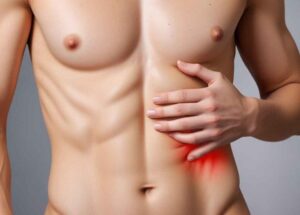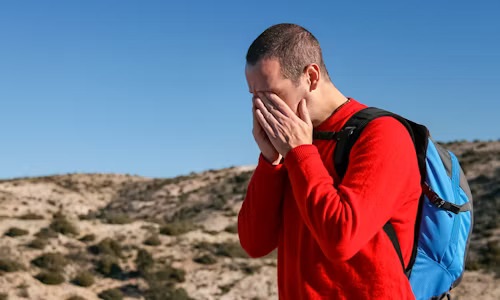After gallbladder removal surgery, known as cholecystectomy, some people may continue to experience abdominal pain, particularly in the upper right part of their belly. This can be concerning, but it’s important to know that this pain can be caused by several factors, and there are ways to manage it effectively.
Why Do I Still Have Pain After My Gallbladder is Removed?
The gallbladder stores and releases bile, a juice made by the liver that helps digest fats in the small intestine. When gallstones form, they can block the flow of bile, causing pain and swelling. Taking out the gallbladder gets rid of these problems. But sometimes, even after surgery, people still feel pain in the upper right part of their belly. Here are some reasons why:
- Post-Cholecystectomy Syndrome (PCS): This happens to about 10-20% of people after surgery. It can feel like gallstone symptoms, with crampy pain in the upper right belly, feeling sick, throwing up, and feeling bloated. We’re not sure why it happens, but it might be because of changes in how bile flows or irritation of the bile ducts during surgery.
- Missed Bile Duct Stones: Sometimes, gallstones are in the bile ducts outside the gallbladder and doctors don’t spot them during surgery. These stones can still hurt and need more treatment.
- Sphincter of Oddi Dysfunction (SOD): This happens when a muscle valve (called the sphincter of Oddi) near where the bile duct and pancreatic duct meet the small intestine doesn’t work right. It can cause pain like gallbladder attacks. Oddly enough, SOD is more likely to happen after gallbladder removal.
- Other Belly Problems: Things like ulcers, gastritis (when the stomach lining gets swollen), or even straining a belly muscle can also cause pain in the upper right belly, making it seem like post-cholecystectomy pain.
| Category | Details | Sub-Details |
| Postcholecystectomy Syndrome | Collection of symptoms after gallbladder removal | – Symptoms: Abdominal pain, nausea, bloating, diarrhea. |
| – Causes: Retained bile stones, bile duct injury, Sphincter of Oddi dysfunction (SOD). | ||
| – Diagnosis: Ultrasound, MRCP (Magnetic Resonance Cholangiopancreatography), ERCP (Endoscopic Retrograde Cholangiopancreatography). | ||
| Sphincter of Oddi Dysfunction | Spasm or scarring of the sphincter controlling bile flow | – Symptoms: Pain similar to gallbladder attacks, especially after eating fatty meals. |
| – Diagnosis: Sphincter of Oddi manometry, MRCP, ERCP. | ||
| – Treatment: Medication (e.g., muscle relaxants), endoscopic sphincterotomy. | ||
| Retained or Recurrent Stones | Gallstones left in bile ducts or new stones forming | – Symptoms: Persistent right upper quadrant pain, jaundice, pancreatitis. |
| – Diagnosis: Ultrasound, CT scan, MRCP, ERCP. | ||
| – Treatment: ERCP with stone removal, medication to dissolve stones, surgery if necessary. | ||
| Bile Leak | Leakage of bile from ducts post-surgery | – Symptoms: Severe abdominal pain, fever, jaundice, bile collection in the abdomen (biloma). |
| – Diagnosis: Imaging studies (CT, HIDA scan), blood tests for liver function. | ||
| – Treatment: Drainage of biloma, ERCP to place a stent, or surgery to repair the leak. | ||
| Other Causes | Non-biliary causes such as irritable bowel syndrome (IBS) | – Symptoms: Abdominal pain, bloating, changes in bowel habits, unrelated to bile duct issues. |
| – Diagnosis: Exclusion of biliary causes, colonoscopy, and other gastrointestinal evaluations. | ||
| – Treatment: Dietary changes, medications (e.g., antispasmodics, laxatives), stress management. |
| Related: Female Gallbladder Surgery Recovery Time |
Causes of Upper Right Abdominal Pain After Gallbladder Removal
Experiencing upper right abdominal pain after gallbladder removal (cholecystectomy) is common and can have various causes. Here are some possible reasons:
- Bile Duct Injuries: During surgery, there’s a chance of injuring the bile ducts, which can cause pain and complications later on.
- Sphincter of Oddi Dysfunction (SOD): This involves problems with a valve controlling bile and pancreatic juice flow, causing pain in the upper right belly.
- Biliary Dyskinesia: This happens when bile ducts don’t work right, leading to pain, especially after eating fatty foods.
- Post-cholecystectomy Syndrome (PCS): This term covers ongoing symptoms like abdominal pain, bloating, nausea, and diarrhea after gallbladder removal.
- Stump Syndrome: Sometimes, part of the gallbladder is left behind during surgery, causing ongoing symptoms and pain.
Management Strategies for Upper Right Abdominal Pain
Managing upper right abdominal pain after gallbladder removal involves different strategies, depending on what’s causing the pain. Here are some general ways to manage it:
- Medical Treatment: Depending on the cause, your doctor might give you pain meds, antispasmodics, or bile acid sequestrants to help with symptoms.
- Endoscopic Procedures: They might do a procedure called ERCP to check and treat problems like SOD or bile duct injuries.
- Sphincterotomy: This involves cutting the valve (sphincter of Oddi) to help bile flow better and ease symptoms.
- Lifestyle Changes: Changing your diet, like avoiding fatty foods and eating smaller meals, and keeping a healthy weight can help ease symptoms.
How to Spot the Pain
The pain associated with upper right abdominal pain after gallbladder removal can vary. Here are some features to look out for:
- Location: Typically, the pain is felt in the upper right quadrant of your abdomen, just below the rib cage.
- Intensity: The pain can range from mild discomfort to sharp and cramping.
- Duration: It might be constant or come and go in episodes.
- Accompanying Symptoms: You might experience nausea, vomiting, bloating, gas, or indigestion alongside the pain.

Figuring Out What’s Causing the Problem
Your doctor will probably ask about your health history and check your body. They might also request these tests:
- Blood Tests: They check if your liver or pancreas enzymes are higher than normal, which could mean there’s a problem.
- Abdominal Ultrasound: This test looks at your bile ducts and sees if there are any leftover stones.
- HIDA Scan: It checks how well bile moves through your system.
- ERCP: It’s a special test that uses a scope and X-ray to see inside your bile ducts and maybe remove stones.
| Step | Details | Sub-Details |
| 1. Identify Symptoms | Observe and document the problem | – Physical symptoms: Pain, swelling, temperature, etc. |
| – Behavioral symptoms: Changes in function, performance issues, unusual behaviors. | ||
| – Timing and triggers: When does the problem occur? Are there specific triggers? | ||
| 2. List Potential Causes | Brainstorm all possible reasons for the problem | – Internal causes: Issues within the system, body, or process (e.g., hardware failure, diet). |
| – External causes: Environmental factors, interactions, or external influences (e.g., temperature, stress). | ||
| – Human factors: Errors, misunderstandings, or incorrect usage. | ||
| 3. Gather Data and Evidence | Collect information to narrow down causes | – Diagnostic tools: Use relevant tools (e.g., blood tests, performance logs, diagnostic scans). |
| – Historical data: Review past occurrences, trends, and patterns. | ||
| – Comparative analysis: Compare with normal conditions or other cases. | ||
| 4. Perform Diagnostic Tests | Use targeted methods to isolate the cause | – Physical tests: Examinations, imaging, or inspections (e.g., X-rays, software diagnostics). |
| – Simulation: Reproduce the problem in a controlled environment to observe causes. | ||
| – Process of elimination: Test and rule out potential causes one by one. | ||
| 5. Implement and Evaluate Solutions | Take corrective action based on findings | – Short-term fixes: Apply temporary solutions to mitigate immediate impact. |
| – Long-term solutions: Address root causes to prevent recurrence. | ||
| – Monitor results: Track the effectiveness of the solution and adjust if necessary. |
Living Well After Gallbladder Removal
Dealing with pain after gallbladder surgery can be tough, but there’s help available. Work closely with your doctor to figure out what’s causing your pain and how to treat it. Here are some ideas that can help in pain management:
- Eat Healthy: Stick to a balanced diet with less fat and more fruits, veggies, and whole grains.
- Have Smaller Meals: Eating smaller portions more often can make digestion easier.
- Drink Enough Water: Keeping hydrated aids digestion and prevents constipation, which can make belly pain worse.
- Handle Stress: Stress can make tummy troubles worse. Try relaxation methods like

